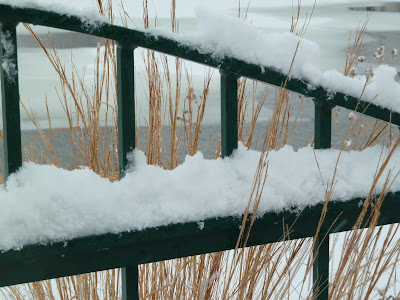Now that the ice is mostly out along the stretch of the Cannon River I keep my eye on, mallards have moved in. Today they were clustered on both sides of the river, facing the sun for the most part, soaking up the rays on this slightly warmer day that's supposed to lead into some even warmer days to come.
 |
| Mallards on the east bank |
 |
| Mallards on the west bank -- but what's that on the right? |
At this time of year we start to see less-common kinds of ducks stopping on on their way north to their summer breeding grounds. Near one group of mallards (above), I noticed a lone, smaller, whiter duck.
This duck had a bluish bill, a dark head, a very noticeable white lower body, a pale gray back, and a dark tail.
There are two ducks fitting this description: the male
greater scaup and the male
lesser scaup. Because the lesser scaup winters all across the southern tier of states, as close to us as southern Missouri, while the greater scaup does not (my Sibley guide shows it wintering along the east and west coasts, while the range map on the link above doesn't even show a winter range in the U.S.), chances are very good this was a lesser scaup. I wonder why he seemed to be alone today; I hope he finds his fellow scaups again.
I'll be watching with interest to see if other less-common ducks make an appearance on the river this spring.
In early April three years ago, I saw and photographed a couple of pied-billed grebes on the river. I
n the second week of April two years ago, I noted I had been seeing a pair of hooded mergansers all week. When the ponds in southeastern Northfield lose their ice, we've had great luck seeing a wide variety of ducks for a few weeks, even including loons. We'll be checking that area out later this week, I'm sure, as the ice and snow melt away and daylight savings time opens up the evenings for birdwatching walks.

































